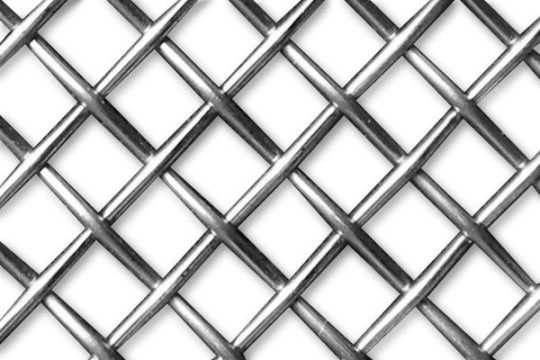Trailer Decking
Trailer Decking Material
Roofing iron, chipboard, pallets, you name it, if it sits flat and can be attached to a trailer, its been used as decking material. While you might get away with this type of decking for a while, one day you’ll lose your load on the road.
There are plenty of good materials on the market for decking and I have listed below, a couple of the standard decking materials as well as a few other options.
Timber Decking
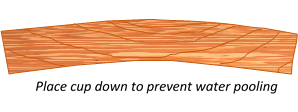
Check that the boards are not cupping, and if they do, position the boards so that the cup is facing downwards onto the chassis.
The wider the boards are, the more severe and more likely they are to cup. A good standard board size for decking is 6” x 2” (140 x 38mm dressed size).
Thickness is dependent on the type of load to be carried. Transporting horses or stock require boards at least 35mm thick (a 50mm board which has been machined or “dressed” will come in at around 38mm thick) ship lapped (to give the boards additional strength) and free of any timber defects.

For general loads with large weight bearing surfaces and with good chassis support (chassis cross members 450-500mm apart) a good hardwood domestic decking material can be used (19mm+ thick). The deck will be stronger if it is ship lapped or tongue and grooved (to prevent individual boards bending under weight).
Any hardwood decking will need to be predrilled before screwing or nailing down to the trailer, and it will make life a little easier to predrill softwood decking material as well unless you have access to an industrial screw machine.
Nailed you ask?? One of the quickest ways of attaching timber boards to a trailer is to fit 50 x 50 (2” x 2”) timber battens to the inside of the cross members with coach bolts and using serrated ring shank or screw shank nails, nail the boards straight to the battens. If using treated timber boards, use hot dipped galvanised coach bolts, screws or nails for fastening the decking down as the treatment chemicals can prematurely corrode plain steel fastenings. Zinc plated screws/nails should not be used as their coating is too thin to offer any protection. Stainless steel fastenings can be used but you may have to take out a small loan out to cover the cost.
Another point to be aware of is that boards will expand when wet and shrink when dry. If you fit wet boards to your trailer, they will shrink once they dry out and you will have gaps either side of the boards, which can trap any loose material. You may also find that the fastenings you used to fix the boards to the trailer may be sitting proud of the deck. All should settle down again when wet but ideally the best time to fit boards to a trailer is when they are relatively dry and leave a 2-3 mm expansion gap along the sides of the trailer and around 4-5mm gap at the tailgate ends.
When fitting boards to the trailer, dry fit the boards across the width of the trailer and measure what gap is left. Divide the gap in half and rip a board down to fit along both sides. Try to rip the boards so that the first and last board are roughly the same width.
Clamp the first board to the trailer (with a 2-3mm packer between the trailer side and the board)making sure that the board is almost flush with the front cross member, drill and screw (or nail), clamp the second board up to the first board, drill and screw and repeat.

If the trailer is to be used in the wet or muddy conditions on a regular basis, it may help to coat the underside of the boards with an oil based sealer or similar prior to fitting to the trailer. Most trailer decks will deteriorate and rot from the underside and any additional protection to the deck will help.
Once the deck is fitted, give the top surface a quick skim with a sander to take any high spots off and either seal as per the underside or leave to weather.
Plywood Decking
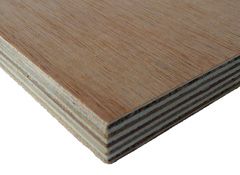
Construction plywood is one of the best grades of ply for trailer decks as it is fully bonded with exterior glues and pressure treated to prevent rot and decay. It does pay to check with the supplier regarding the treatment and glue used, especially if the plywood is abnormally cheap as there are some inferior and substandard imported plywood. Another thing to check is the thickness of the top veneer. Some manufacturers sand the top face so much that the veneer is only paper thin. Within a few months this thin veneer can split, delaminate and deteriorate to the point where the deck is unsightly and the deck surface is increasingly difficult to work with. The top veneer needs to be as thick as possible to ensure the deck surface stays in the best useable condition for as long as possible.
Plywood comes in various grades depending on their end use and will normally have one good face and one of varying quality. It is the good face you need to worry about and you shouldn’t concern yourself too much with the back face unless it is of very poor quality.
Marine grade ply is the ultimate grade for decking plywood and you will have to have a very large wallet or an exceptional need to warrant using this on your trailer.
Plywood comes in the following grades –
A Grade – This is a high quality appearance face for clear finishing and decorative purposes. Marine plywood is only available with an A face on both sides (A-A)
B Grade – This is a relatively high grade face which is suitable for a high quality painted finish. Very minor splits or cracks will be filled with exterior grade putty.
C Grade – a non-appearance grade with small splits and small tight knots and holes which may be filled with exterior grade putty if required.
D Grade – a non-appearance grade which face is un-sanded and with open defects.
"A" “B” or “C” face is suitable for the trailer deck top face with either “C” or “D” for the back face.
For a standard general purpose deck, plywood thickness of 17 or 18mm is more than suitable. If you are transporting large animals or heavy, high point loading items, 22 to 25mm would be recommended. To improve slip resistance, particularly for animals, concrete reinforcing mesh or chicken mesh can be stapled or screwed to the deck.
As with all treated timber, hot dipped galvanised screws or nails (see timber decking above) are the preferred choice for fastening the deck to the chassis. Plain steel or zinc coated/plated fastenings should never be used due to the corrosive nature of the chemicals used in treating the plywood.
Sealing the deck including edges, with an oil based sealer/stain is recommended before fitting to the trailer to give the deck its best chance of a long and useful life.
Phenolic Coated Plywood
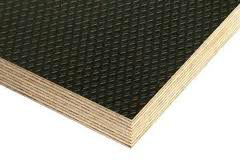
The top face has a thick layer of phenolic coating which gives the plywood a very hard, impact, abrasion and wear resistant surface. This layer has a mesh or diamond plate pattern pressed into the deck to enhance grip and friction for both man and load. The bottom face has a smooth finish which helps prevents moisture and road grime from settling. Coated plywood comes in a small range of colours with brown and green being the most common.
Because of the thinness of the veneers, the resulting boards are structurally stable and have exceptional strength, hence thinner boards can be used where heavier and thicker boards would normally be utilised.
For example where a 19mm plywood board would be standard on a trailer, a 12mm phenolic coated ply could be used without compromising strength if looked after correctly.
Coated plywood is not treated and relies on its coating to give protection from moisture. Any cut or machined edge where the plywood has been modified to fit the trailer will need a least two coats of protective paint to prevent any moisture from getting in. Larch has relatively good resistance to moisture induced rot, but birch, which is more common in coated plywood, is more suited to interior applications due to its poor relationship with moisture. Nevertheless, birch works well in decking applications as long as any cut edges are sealed and any fastening holes are sealed in some way to prevent water from getting in.
Personally, I would squirt a good dose of silicon sealant down the drill holes before inserting the fastenings and top it off with a coat of colour matched paint. Any gouges or any decent scratches in the top face should be given a quick touch up with paint to prevent any water getting into the interior of the ply.
Phenolic coatings are reasonably UV resistant but the coating colours will fade under harsh sunlight. Phenolic coated plywood is also called Trans deck and Form ply.
For phenolic coated plywood suppliers in New Zealand - give Plytech International Ltd a call on 0800 900 905.
Alloy Decking
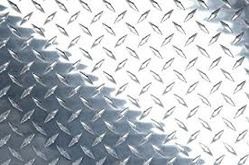
Aluminium decking is relatively quick and easy to fit to trailers and if you are able to source sheets of the correct size, can be folded to become a one piece sides and deck (bathtub) unit. This is great if you are towing a lot of loose material or animals as there are no side gaps for material and crap to fall into and makes cleaning a breeze.
Aluminium tread plate comes in a range of thicknesses and depending on the end use 2.5mm up to 6mm are normally suitable.
Flat aluminium sheets without the raised tread plate design are equally at home on a trailer, but beware of slipping and sliding on flat aluminium decking especially when wet.
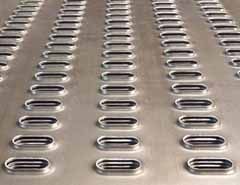
A word of warning if you are using an aluminium decked trailer for transporting firewood, bricks or items with a high point loading. Because aluminium is a soft and ductile material, when aluminium is bent, damaged or dented through normal use, it stretches and deforms and will not retain its original flat surface or shape. If there is not enough decking support or the load placed between the deck supports is excessive, the deck can buckle and deform. When items like firewood or bricks are thrown onto the trailer the buckling will give the deck a skeletal look and if severe enough, will even pop the deck off the fastenings holding the deck to the chassis.
To prevent damage to the deck, you can either fit extra chassis support for the deck or line the deck with a thinner plywood deck before fitting the aluminium.
Aluminium and steel are dis-similar metals and if placed together can generate a mild galvanic reaction where the steel in the chassis can start to corrode rapidly, especially where there is an electrolytic conductor such as water (flung up from wet roads) and in particular salt water (even air borne) around. While galvanised steel and aluminium are not as reactive as bare mild steel and aluminium, there is the chance of some reaction especially around the areas where the deck is fastened to the chassis.
To reduce the reaction it pays to separate the two metals with either applying a bead of neutral cure silicon or rubber tape (or similar) to the trailer chassis before laying the aluminium deck on. This has an added benefit of reducing any vibration and deck noise. Even painted trailers can benefit from having the deck separated from the chassis as the paint under the deck will wear away over time.
Fastening the deck to the chassis is a bit trickier to prevent the two metals touching. If you are really serious about reducing contact, I would drill oversize holes in the deck and apply neutral cure silicon or a similar insulating paste into the hole before fitting the fastener with a rubber/silicon washer. Standard fasteners for fitting aluminium decks to steel chassis’ are hot dipped galvanised screws or at a pinch, alloy rivets.
Zinc plated or stainless steel fastenings should not be used as they will encourage further and faster galvanic reactions.
Steel Decking
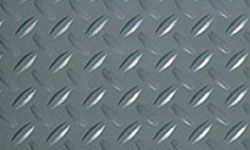
Steel decking can be either flat plate or with the raised tread plate design similar to the aluminium decking or open mesh (see below). Steel has a natural tendency to bounce back to its original state if abused and is easy to repair if anything major is required.
3mm steel plate is really the ideal thickness you want and this will cope with just about anything you can throw at it. A flat sheet of 3mm steel, 1.2 x 2.4m, weighs approximately 70kgs with a 3mm tread plate sheet the same size, coming in at 75kgs. For comparison, a 6mm aluminium sheet comes in at around 53kgs.
One advantage with steel is the relative ease in getting sheets cut to the correct size for your trailer. Steel decking can be welded, coach bolted or screwed to the chassis. If the trailer is to be welded, particularly if the trailer is to be galvanised, care needs to be taken to ensure that welding stresses are not put into the chassis as these may cause the chassis to twist and distort when heated in the galvanising bath. Welded steel deck trailers that have been galvanised tend to expand between cross members and have a skeletal look to them.
Predrilling steel decks and galvanising the trailer and deck separately normally have a better result in both looks and a straightness of the chassis. 3mm steel can be purchased already hot dip galvanised and may be the best option if bolting/screwing the deck to the trailer.
Fitting a galvanised deck on a painted trailer looks smart and gives the deck and trailer a considerably longer life.
Flat steel decks can be very slippery when wet and even tread plate decks can be a hazard.
